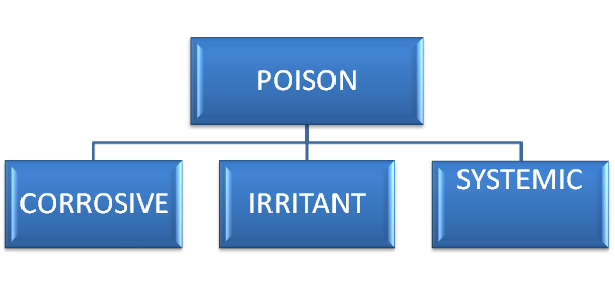TOXICOLOGY: the science that deals with the properties, actions, toxicity, fatal dose, estimation, treatment and autopsy findings in relations to the poisonous substances.
FORENSIC TOXICOLOGY: it is the use of toxicology and its disciplines to aid legal investigation of death, poisoning or drug use. It is use of toxicology for the purpose of law.
POISON: is a substance, which on ingestion, inhalation, absorption, injection, or development in the body may cause structural or functional disturbance to the body to injure health or to destroy the life.
There is minute difference between a poison or medicine. Medicine in a toxic dose is a poison and a poison in a small dose is a medicine. If the substance is giving with an intent to save a life, it is a medicine but if it is given with an intent to harm the life the it is said to be poison.
ACUTE POISONING: is caused by the excessive single dose or several dose of a poison taken over a short period of time.
CHRONIC POISONING: is caused by the small doses over a long period of time, resulting in gradual worsening.
SUBACUTE POISONING: shows feature of both acute and chronic poisoning.
FULMINANT POISONING: is caused by massive doses of poisoning where death occur rapidly, sometimes without preceding symptoms.
CLASSIFICATION OF POISON ON THE BASIS OF MODE OF ACTION
It may be classified on the basis of mode of action:

- CORROSIVE: a corrosive poisons is highly active irritant and not only produce inflammation but also cause ulceration of tissues. It destroys, erodes a surface with which it comes in contact with. It consists of strong acids and strong alkalies.
- Strong acids: it includes mineral acids such as sulphuric acid (H2SO4) and hydrochloric acid(HCl). Organic acids such as acetic acid, carbolic acid, salicylic acid.
- Strong alkalis: concentrated alkalis such as hydrates and carbonated of sodium, potassium and ammonia.
- Mineral salts: copper sulphate, potassium cyanide, chromates and dichromate.
- IRRITANTS: irritant poisons cause pain in abdomen, vomiting and purging. In post-mortem appearance, they usually show redness and ulceration of the gastrointestinal tracts. The corrosive in dilute solution acts as an irritants.
The group is divided into: inorganic, organic and mechanical.
a. Inorganic irritant poison: it consists of metallic and non-metallic poisons. Examples of metallic poisons are phosphorous, chlorine, bromine and iodine. Examples of non-metallic poisons are lead, copper, arsenic, zinc and radioactive substances.
b. Organic irritant poison: this group consists of animal and plant poisons. Animal poisons include snack, cantharides, spiders etc. plant poisons include marking nut, abrus precatorius, calotropis etc.
c. Mechanical irritant poison: this group includes powdered glass, diamond dust, chopped hair, dried sponge.
3. SYSTEMATIC POISON: this group affects the organs of the body parts and thus they are referred to as a systematic poisons. It includes:
a. Neurotics poison: they acts mainly on the nervous system. All alkaloids fall under this categories. This group of poisons acts mainly on the cerebral, spinal and peripheral nerves.
- Cerebral systematic poison: they acts mainly on the cerebral part of the brain. This poisons have somniferous, deliriants, or inebriants effects. The somniferous include opioids, the inebriant poisons includes alcohols, sedatives, and agrochemical compounds. The deliriants poisons include dhatura, belladonna etc.
- Spinal systematic poison: this poisons acting on spinal chord includes nux vomica and its alkaloids and gelsemium.
- Peripheral systematic poisons: the poisons acting mainly on peripheral nerves includes curare and conium.
b. Cardiac poisons: these are poisons acting on the heart includes digitalis, oleander, aconite and nicotine.
c. Asphyxiants poisons: those poisons that affect respiratory system and includes irrespirable gases such as carbon monoxide, sewer gases and war gases.
d. Miscellaneous poisons: the poisons that have different actions except those described above comes inn this group. Examples include street drugs, food poisoning, analgesics.
CLASSIFICATION OF POISON BASED ON THE NATURE OF POISON
- Gaseous poison: these types of poisons are gaseous in nature and when inhaled affect the oxygen carrying capacity of the blood and damages the respiratory system. Examples are carbon monoxide, carbon di-oxide, nitrous oxide, war gases etc.
- Volatile inorganic poison: acute poisoning with volatile substances usually follows the slow inhalation of vapors to cause affect. Examples re cyanide, arsine, phosgene, chloride, etc.
- Volatile organic poisoning : these poisons cause large molecules to sublimate from the soli and liquid to form gas and mix in the atmospheric air. Ethanol, formaldehyde and acetaldehyde are few examples of volatile organic poisons.
- Non volatile organic poisons: this include acidic and basic drugs. Acidic poisons include phenolic compounds, salicylates etc. they are acidic and combines with bases to form salt. Basic poisons includes alkaloids and benzodiazepine.
- Non volatile inorganic poisoning : this includes cations and anions poisons. Examples of anion poisons include halides, dichromate, cyanide, sulphate etc. and of cations includes lead, mercury, arsenic, etc.
- Plant poisoning : the component of plant that adversely affects are organic compound and non volatile in nature. Examples- dhatura, balladona, nux vomica etc.
- Miscellaneous poisons: this includes:
a. Mechanical poisoning : diamond dust, glass powder, chopped hair.
b. Food poisoning: mycotoxins
c. Animal or insect poisoning: snake, spider, bees, etc.
For more updates, subscribe to our blog.





